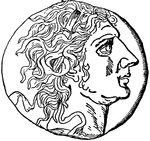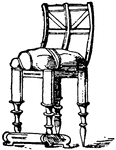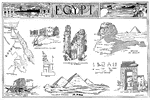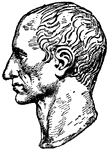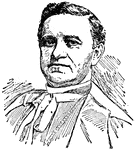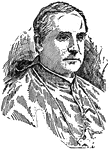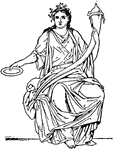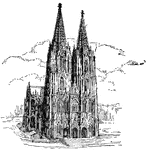
Babylonia Poster
A poster of ancient Babylonia: Chaldea, Assyria, Persia, soldiers, religion, writing, and structures.
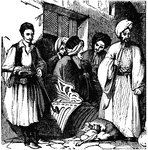
Life in Constantinople
In the streets of Constantinople one might find lemonade sands, sweetmeats, coffee, and pipes and at…

Modern Printing Press
"The printing press- originating at the middle of the fifteenth, the art of printing continued to be…

Ptolemy in Profile
He was a mathematician, geographer, astronomer, and astrologer. "The name of a line Graeco-Egyptain…

Sir Walter Raleigh
Sir Walter Raleigh, navigator, warrior, statesman, and writer in the reigns of Elizabeth and James I.,…
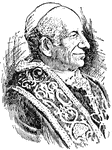
Leo XIII
Pope Leo XIII (1810-1903). Archbishop, bishop, cardinal, chamberlain of the Sacred College, and Pope.
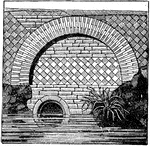
Reticulated Work
A species of masonry very common among the ancients, in which the stones are square and laid lozenge-wise,…

Theodor Mommsen
(1817-1903) German historian and archaeologist most celebrated for his work with Roman history.
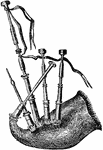
Bagpipe
The bagpipe is a wind instrument used among the ancient Greeks but is known as a Scottish and Irish…

Roman Sarcophagus Tomb
A coffin or tomb of stone; a kind of stone chest, generally more or less ornamented for receiving a…
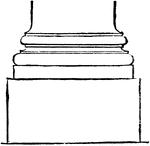
Scamillus
In ancient architecture, a sort of second plinth or block under a column statue, to raise it.

Medulla
Dorsal or posterior view of the medulla, fourth ventricle, and mesencephalon. Labels: p.n., line of…

Fourth Ventricle with the Medulla Oblongata and the Corpora Quadrigemina
Fourth ventricle with the medulla oblongata and the corpora quadrigemina. The roman numbers indicate…
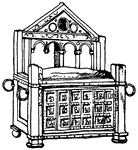
Chair of St. Peter Arm-Chair
The chair of St. Peter was made out of wood with ivory reliefs illustrating the story of Hercules in…

Roman Arm-Chair
The Roman Arm-chair had a decoration symbolic of Ceres, the Roman goddess of growing plants.

Roman Bedstead
This Roman bedstead had a Pompeian vase-painting. It included a head and foot board. It was made out…

Ancient Persian Throne
The Ancient Persian Throne was decorated to represent a king sitting on his throne borne-up by slaves.

Pinna Rudis (Linnaeus)
"The genus Pinna was so called from its resemblance to the plumelet which the Roman soldiers…

Pinna Nigrina (Lamarck)
"The genus Pinna was so called from its resemblance to the plumelet which the Roman soldiers…

Pinna Nobilis, with its byssus (Linnaeus)
"The genus Pinna was so called from its resemblance to the plumelet which the Roman soldiers…

Pinna Bullata (Swainson)
"The genus Pinna was so called from its resemblance to the plumelet which the Roman soldiers…

Construction of a Portion of Appian Way
A famous road with many branches which connected Rome with Southern Italy

Fates
The three fates of Greek Mythology were three sisters who spun the thread of life named Clotho, Lachesis,…
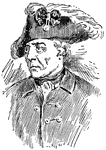
Frederick II
(1712-1786) King of Prussia from the Hohenzollern dynaasty, known as the founder of Germany's military…

Portion of Rosetta Stone
"In the Nile valley there had been found a few ancient inscriptions, carved upon stone in unknown characters,…
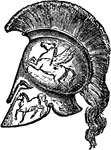
Helmet
The oldest use of helmets was by Ancient Greek soldiers, who wore thick leather or bronze helmets to…

Cathedral Spires in the Garden of the Gods, Colorado
The outstanding geologic features of the park are the ancient sedimentary beds of red and white sandstones,…

Ruins at Stonehenge
Stonehenge is a prehistoric monument located in the English county of Wiltshire, about 3.2 kilometres…
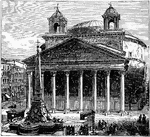
The Pantheon at Rome
The Pantheon is a building in Rome which was originally built as a temple to all the gods of Ancient…
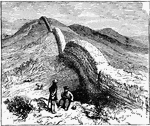
Hadrian's Wall
Hadrian's Wall is a stone and turf fortification built by the Roman Empire across the width of what…
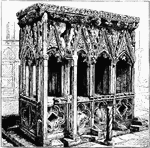
St. Alban's Shrine
Saint Alban was the first British Christian martyr. Along with his fellow saints Julius and Aaron, Alban…

The City of Constantinople (Byzantium)
Byzantine Constantinople had been the capital of a Christian empire, see Christendom, successor to ancient…
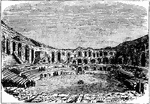
Roman Amphitheatre at Arles
The Arles Amphitheatre is a Roman amphitheatre in the southern French town of Arles.

Roman Soldiers
The distinction between rank and unit type doesn't seem to have been as precise as in a modern-day army,…
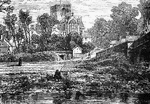
St. Asaph Cathedral
St Asaph Cathedral, (Welsh: Eglwys Gadeiriol Llanelwy) at St Asaph, Denbighshire, north Wales, is sometimes…
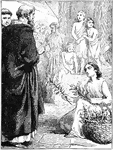
The Angli in Rome
The Angles is a modern English word for a Germanic-speaking people who took their name from the cultural…

Roman Lighthouse, and Part of St. Mary's Church, Dover
The lighthouse on the Eastern Heights still stands in the grounds of Dover Castle to 80 foot (24 m)…

St. Paul's Cathedral
St Paul's Cathedral, is the Anglican cathedral on Ludgate Hill, in the City of London, and the seat…

The Door of the Roman Bridge
This image depicts the door leading to the Puente Romano, a Roman bridge in Cordoba, Spain.
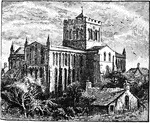
Hexham Abbey
There has been a church on the site for over 1300 years since Etheldreda, Queen of Northumbria made…
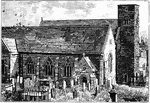
Monkwearmouth Church
The present parish church of St. Peter's at Wearmouth, on the north bank of the River Wear, occupies…



